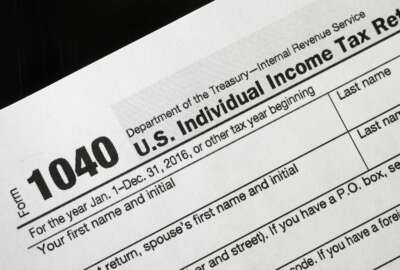
Don’t forget to file: Avoiding an audit
If you haven’t done your taxes yet, no problem. There's still plenty of time. If you are planning not to pay your taxes, that is a problem.
Best listening experience is on Chrome, Firefox or Safari. Subscribe to Federal Drive’s daily audio interviews on Apple Podcasts or PodcastOne.
If you haven’t done your taxes yet, no problem. There’s still plenty of time. If you are planning not to pay your taxes, or not to file at all, that is a problem that, worst case scenario, could see you doing time in a federal pen.
Most federal workers are paid via tax dollars, so ordinary taxpayers are not amused when they read a rare story about a civil servant dodging taxes. So do feds, for that matter, who pay their fair share on time. And while most people, both feds and everybody else, pay their taxes on time or are on payment plans with the IRS, the big problem comes when non-filers get caught. Many of us know people who haven’t filed, even if we don’t actually realize it. According to the most recent data the IRS has identified 1.6 million non-filers. So what happens if you or a friend are one of them? And what should you be aware of during the filing season?
We also wanted to sort out the many scams people use posing as IRS agents or revenue officers. The IRS doesn’t call or email you asking for back taxes. You may hear from them but it will be in the form of a revenue officer, with credentials.
To get some answers to tax-time questions, including those you should be considering, I asked D.C. area Tom O’Rourke to join me today at 10 a.m. EDT on our Your Turn radio show. Tom worked for the IRS for many years before going into private practice. Here’s his outline for today’s show:
Since we are in the middle of tax filing season, I thought it might be helpful to discuss taxes on Wednesday’s show, beginning with the new IRS program and rules for dealing with non-filers. Here’s what he said:
“For the tax year 2018, the most recent year for which information is available, the IRS identified 1.6 million individual non-filers. In an effort to reduce the number of non-filers, the IRS has initiated its non-filer initiative. It intends to send revenue officers to personally meet with taxpayers and advise them of their obligation to file and to encourage them to voluntarily comply with the tax law and to file their returns. The individuals most likely to be visited are those with incomes of more than $100,000.
“This initiative is not to be confused with the scam phone calls many individuals who have received in recent years advising them that they will be arrested unless they immediately make a payment — many times by way of buying gift cards. In Information Release 2020-34 the IRS told taxpayers what they should look for to determine that the contact is not a scam. Specifically, IRS advises that:
- The initial visit by a revenue officer will be unannounced.
- The IRS revenue officer will have official credentials that includes a photo id.
- A legitimate revenue officer will explain an individual’s tax obligations and help the taxpayer understand why they have the liability. They will not make threats or demands and will explain the basis for the outstanding liability.
- An in person visit will generally only occur after numerous attempts to contact the taxpayer by mail.
- The revenue officer will explain the options for paying the liability the taxpayer may have including the right to enter into an installment agreement.
“While there are significant numbers of individuals who do not comply with the tax laws, the overwhelming number of people voluntarily comply and file their tax returns on time. Most taxpayers prefer not to have deal with the IRS beyond simply paying their taxes. The individual audit rate is one audit for 170 returns filed (.59%). The higher a person’s income, the greater the likelihood of an audit. For example, [for] taxpayers with incomes[] between $100,000 and $1 million, the audit rate is 1.4%, and the audit rate for a person with income[s] of more than $1 million is slightly more than 3%.
“According to a recent article in Kiplinger’s Personal Finance, some of the factors likely to trigger an audit are as follows:
- Failing to report all income. Most of your income is already reported to the IRS by the payor of that income. The Form W-2 or 1099 sent to you is also sent to the IRS.
- Claiming higher than average itemized deductions.
- Taking large charitable contribution deductions.
- Claiming losses from rental activities.
- Deducting expenses of a hobby.
- Deducting 100% of your vehicle expenses.
- Deducting meals and entertainment.
- Operating a marijuana business.
- Taking early distributions from a tax deferred account.
- Claiming an alimony deduction.
- Failing to report gambling winnings.
- Engaging in cash transactions.
- Failing to report a foreign bank account.
- Claiming a foreign earned income exclusion.
“The best way to avoid any problems with the IRS is to simply honestly report your income and deductions and to file your returns on time. And if you don’t have the money to pay your taxes, you should file by April 15 and avoid incurring the failure to file penalty (5% for each month the return is delinquent up to 25%). If you do owe money and can’t pay it the IRS has a variety of programs to allow you to satisfy any liability over time.”
Nearly Useless Factoid
By Amelia Brust
Venezuela recently saw its first eco mural completed in the capital city of Caracas. Oscar Olivares, in collaboration with the local environmental organization OkoSpiri and Movimiento en la Arquitectura para el Futuro (Movement in Architecture for the Future) spent two-and-a-half months plastering more than 200,000 plastic caps on a 45-meter-long wall in Plaza Escalona. Using a pointillism technique of color and dots, the mural depicts the city, as well as macaws, sunflowers, mountains from the El Ávila National Park, and green meadows under a starry sky. The work spans from heights of 3.5 meters to 7.25 meters.
Source: Proyectosmaf.com
Copyright © 2024 Federal News Network. All rights reserved. This website is not intended for users located within the European Economic Area.
Mike Causey is senior correspondent for Federal News Network and writes his daily Federal Report column on federal employees’ pay, benefits and retirement.
Follow @mcauseyWFED





